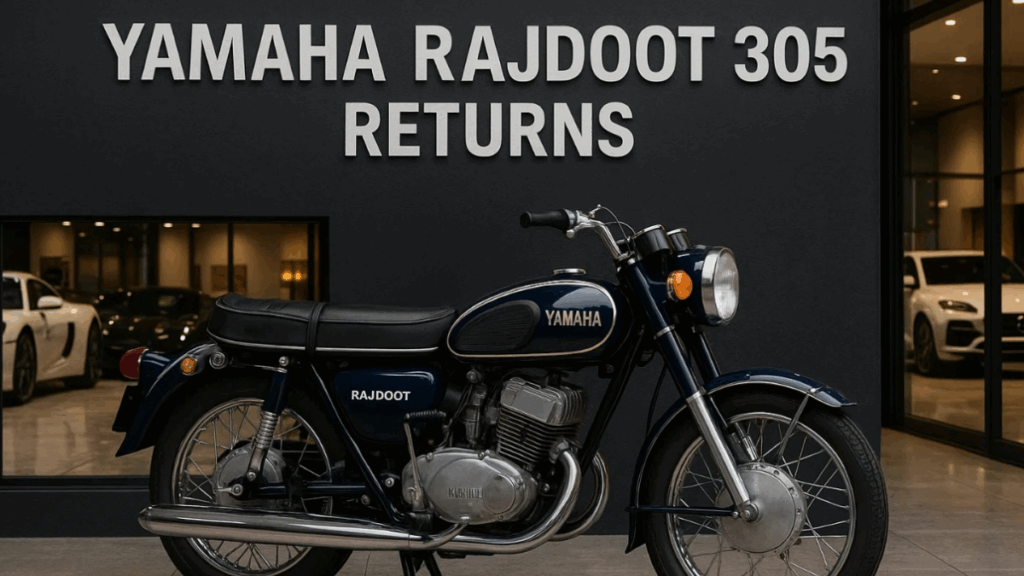The Indian two-wheeler market has always been full of iconic motorcycles that left lasting impressions on riders. From commuter-friendly bikes to performance machines, each era brought something unique to Indian roads. Among these legends, the Yamaha Rajdoot 305 stands out as one of the most memorable motorcycles ever introduced. It wasn’t just a machine; it became a symbol of freedom, power, and prestige. Even decades after its release, the Rajdoot 305 continues to be remembered as a true classic that redefined motorcycling in India.
In this article, we will explore the history, design, performance, legacy, and possible future revival of the Yamaha Rajdoot 305, along with why it still holds such a strong emotional connection for bike lovers.
The Birth of the Yamaha Rajdoot 305
The Rajdoot brand had already gained popularity in India through smaller commuter motorcycles that were affordable and practical. However, in the 1980s, Yamaha partnered with Escorts to introduce a bigger, more powerful model—the Rajdoot 305.
At a time when most motorcycles in India had modest engines between 100cc and 150cc, the Rajdoot 305 arrived like a storm with its twin-cylinder two-stroke engine. It was unlike anything Indian riders had experienced before. The bike promised thrilling performance, bold styling, and an aura of prestige that set it apart from its rivals.
Design That Turned Heads
The Yamaha Rajdoot 305 was designed with a focus on strength and style. Its muscular fuel tank gave it a commanding presence, while chrome-plated exhaust pipes added a touch of elegance. The large round headlamp, wide handlebars, and upright seating position provided both comfort and a vintage look.
Unlike lighter commuter motorcycles, the Rajdoot carried a robust and heavy frame that provided excellent stability on highways. The combination of durability and style made it a desirable motorcycle for young riders who wanted a bike that looked as powerful as it felt. Even today, restored Rajdoot 305s are admired for their timeless retro design.
Performance and Engine Power
The true magic of the Rajdoot 305 lay in its engine. It was powered by a two-stroke twin-cylinder motor, which delivered smooth yet aggressive acceleration. For many riders, the unforgettable roar of the exhaust became the signature identity of the Rajdoot 305.
While the official performance figures varied depending on the year of production, the motorcycle was capable of speeds that most Indian bikes of that era could not dream of. Riders appreciated its raw power, which made it suitable not only for city rides but also for long-distance touring.
Fuel efficiency, however, was not its strongest suit. The Rajdoot 305 was known for higher fuel consumption compared to smaller bikes. But for enthusiasts, the trade-off was worth it, as the thrill and performance far outweighed mileage concerns.
A Motorcycle Ahead of Its Time
In many ways, the Yamaha Rajdoot 305 was ahead of its time. During the 1980s and 1990s, Indian riders were still transitioning from small-capacity commuter bikes to performance-oriented machines. The Rajdoot 305 introduced Indian motorcyclists to the idea of owning a bike not just for transportation but for passion and excitement.
Its robust build quality, coupled with Yamaha’s engineering, meant that the motorcycle could handle rough Indian roads with ease. It also became a status symbol, owned by riders who wanted to stand out from the crowd.
Challenges and Decline
Despite its appeal, the Yamaha Rajdoot 305 faced challenges in the Indian market. Its relatively high price limited its reach, and the two-stroke engine was not the most fuel-efficient option for the average commuter. Additionally, as the years passed, stricter emission norms and the introduction of more efficient four-stroke motorcycles reduced demand for the Rajdoot 305.
By the late 1990s, production slowed down, and eventually, the motorcycle was phased out. Yet, its legacy continued to grow stronger with every passing year.
Legacy and Cult Status
Today, the Yamaha Rajdoot 305 is considered a collector’s gem. Vintage bike enthusiasts actively seek out old models, restoring them to their original glory. At motorcycle rallies, auto expos, and vintage bike shows, the Rajdoot 305 often becomes the star attraction.
Its rarity, combined with the nostalgia of older generations, has turned it into a motorcycle with cult status. Riders who once owned it often recall the sense of pride that came with riding such a powerful machine in an era dominated by smaller bikes.
Why Enthusiasts Still Love It
There are several reasons why the Rajdoot 305 still enjoys immense popularity among motorcycle lovers:
- Iconic Design: Its retro look remains timeless and continues to inspire modern motorcycle styling.
- Powerful Engine: The thrill of the twin-cylinder two-stroke engine is unmatched.
- Nostalgia Factor: It reminds riders of a golden era of Indian motorcycling.
- Collector’s Value: Owning a Rajdoot 305 today is like owning a piece of history.
- Emotional Bond: For many, it was their first performance bike, making it unforgettable.
The Dream of a Modern Revival
With the current trend of retro-inspired motorcycles gaining popularity, many enthusiasts dream of a modern revival of the Yamaha Rajdoot 305. Imagine a bike that carries the design DNA of the original Rajdoot but comes equipped with modern technology—fuel injection, ABS, digital consoles, and a fuel-efficient four-stroke engine.
Such a revival could attract both seasoned riders who loved the original and young bikers looking for a stylish, performance-oriented motorcycle with a legendary name. Although Yamaha has not announced any official plans, the idea of a Rajdoot comeback continues to spark excitement in motorcycle communities.
Conclusion
The Yamaha Rajdoot 305 was more than just a motorcycle—it was an icon that redefined the Indian biking culture. With its bold design, powerful engine, and unmatched road presence, it offered a riding experience that was truly ahead of its time. Even though production ended years ago, the Rajdoot 305 continues to live on in the hearts of enthusiasts and collectors.
For India’s biking history, it remains a shining chapter that represents passion, power, and pride. And who knows? With the growing interest in retro motorcycles, the Rajdoot 305 may one day roar back to life in a modern avatar, ready to inspire a whole new generation of riders.


